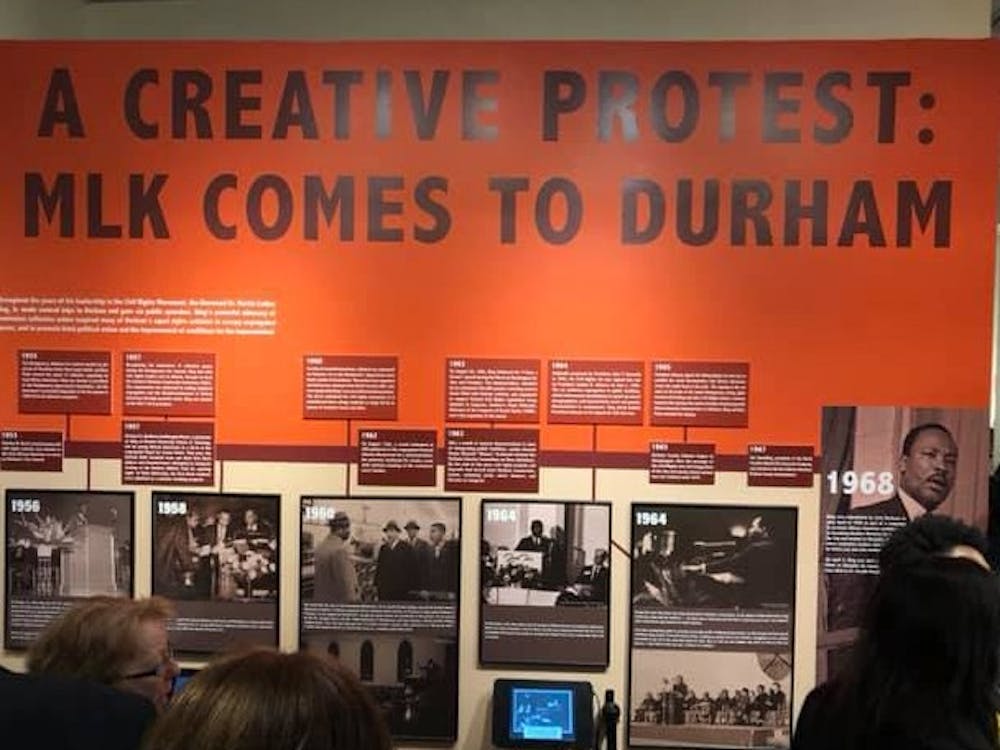It was the best ice cream in town. It was in the heart of Durham and its black community. Yet it was a site of segregation. When, on June 23, 1957, seven African American students led by Rev. Douglas Moore visited Royal Ice Cream Parlor and sat in the section reserved for white customers and refused to leave, they were arrested and later appealed their case to the Supreme Court.
While the Royal Ice Cream sit-in ignited widespread controversy within Black and white communities in Durham, many young African American students were inspired by the Royal Ice Cream protestors — now known as “The Royal Seven” — and followed their lead, which would eventually lead to the desegregation of Durham’s public spaces.
In these crucial years of nonviolent protests between 1956 and 1964, Martin Luther King, Jr. made several visits to Durham and gave six speeches. His most notorious was “A Creative Protest,” a speech delivered at the White Rock Baptist Church on Feb. 16, 1960, where he called for nonviolent demonstrations and appealed to students to fight for change in peace.
“Separate facilities, whether in eating places or public schools, are inherently unequal,” King said. “The underlying philosophies of segregation are diametrically opposed to democracy and Christianity, and all the dialectics of all the logicians of the world cannot make them lie down together.”
Sixty years later, the Museum of Durham History commemorates Dr. King’s influence on Durham and its residents in a new exhibition titled “A Creative Protest: MLK Comes to Durham.” In a grand opening last Friday, new residents and Durham natives as well as contemporary witnesses, former North Carolina state senator Floyd McKissick, Jr. and Durham public historian Eddie Davis came to celebrate the new exhibition, share their stories and communicate living history.
Among the living history was Virginia Williams, who belongs to the “Royal Seven.” She remembers all too well the challenges they faced in the ‘50s and ‘60s as members of a new protest movement, including combatting an all-white Superior Court jury and receiving very sparse media attention. The exhibition highlights the Royal Ice Cream sit-in in a special section.
“People are talking about it again,” Williams said. “It’s picking up a whole lot of steam.”
Being at the center of civil rights movements at the time, Williams felt particularly inspired by King and his efforts in Durham. “I saw him each time he came here,” she said.
In a small but colorful space, the museum visually demonstrates King’s visits to Durham on a timeline, featuring witnesses’ stories, old newspapers and residents’ protest efforts, such as the famous sit-in by the “Royal Seven.” For people willing to share their stories — of which there were many during the opening reception — an interactive tool was provided to record them.
Many visitors appreciated the museum’s effort to highlight activism for racial justice and African American history in Durham. The Museum of Durham History is rather unique in its approach compared to other history museums, which traditionally showcase more artifacts and documents.
“We try to get oral history from people to form a living connection,” said Jeanette Shaffer, director of operations at the Museum of Durham History.
Among the visitors on Friday was Mary White, who did not grow up in Durham but moved here for its history. “Durham is uplifting African American community – that’s why I came here,” she said.
In an enthralling speech, McKissick, Jr. — son of the late civil rights activist Floyd McKissick — described what his life looked like growing up in the 1950s and ‘60s in Durham. Threats by the Ku Klux Klan, bullies at school and segregated spaces belonged to his daily life.
Going to an inclusive school, while signifying a small step forward, turned out to be a nightmare at times.
“They would sit there and say what their daddies would do to your daddy,” he recalled.
Many of his African American peer students faced the same problems, and some would transfer back to segregated schools. All the while, King was a great inspiration for McKissick and his family.
“[King] deserves all the recognition that he has received up to this day,” he said.
McKissick urged the audience to commemorate King and recognize the progress that has been made. “But are we there yet? No. We have a long way to go,” he added.
“A Creative Protest: MLK comes to Durham” will be on display from Jan. 17 to April 5 at the Museum of Durham History.
Get The Chronicle straight to your inbox
Signup for our weekly newsletter. Cancel at any time.

